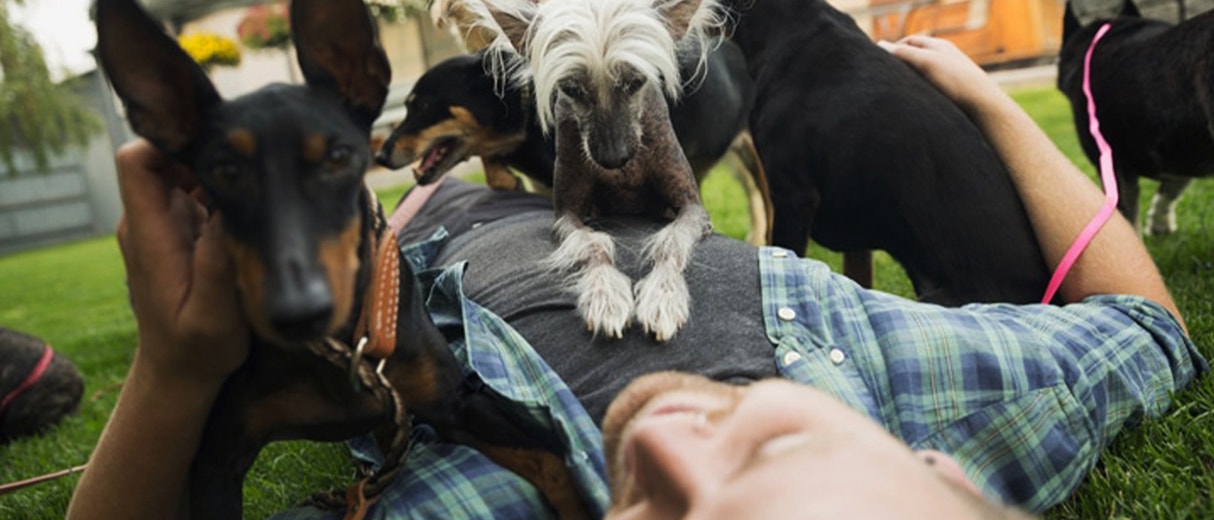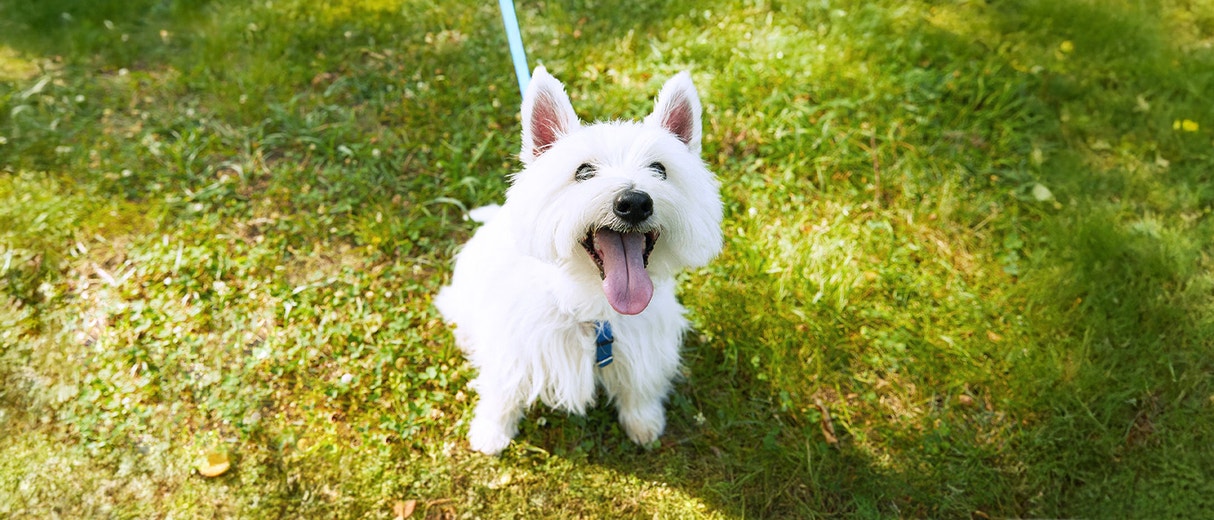
12 Tips for Flying with Your Dog
Picture flying from your dog’s perspective: Getting on a plane is very different from sticking your head out the car window and feeling the wind in your fur! The unfamiliar sights, sounds and smells can be scary for your dog, and even more so when they’ll be spending the flight beneath the seat in front of you or on their own in the cargo hold.
But flying with dogs doesn’t have to be so scary for them — or stressful for their humans. Getting there can still be half the fun if you use the 12 tips below to prioritize your dog’s health and safety along the way. In addition to these tips, make sure you're familiar with the airline’s pet policy, restrictions on pet travel in the U.S. and any additional international pet travel restrictions at your destination.
Before You Book
1. Talk to Your Vet
Is air travel a good idea for your dog? Flying may not be a first choice for dogs with serious health conditions (like respiratory problems) and it can interrupt strict medication schedules (like insulin for diabetic dogs) in unexpected ways.
We recommend talking to your vet about your dog’s health and discussing any concerns they might have about taking your dog with you on a plane in general. When your vet gives you the all-clear, then it’s time to decide …
2. Dog in Cabin or Cargo Hold?
Choose where your dog will spend the duration of the flight before you book your tickets. Smaller dogs (generally under 20 lbs.) may be the right size to travel in the cabin with you, but what about their temperament? Airlines can specify that dogs must be well-behaved (not prone to disturbing passengers with noises or smells) to travel in the cabin and reserve the right to refuse to board disruptive pets. It’s important to be honest about how your dog tends to react to traveling among strangers and plan accordingly.
Also, keep in mind that a carrier you bring into the cabin with you will likely count as a piece of carry-on luggage.
3. Book Your Flight Early
Most airlines only allow one or two dogs on each flight, so it's important to book your dog's ticket early — but don’t click “confirm” just yet! We recommend calling the airline directly to make sure there is a "seat" available for your dog. Confirming with an agent helps avoid any availability problems that might crop up through their website. Once the agent gives you the all-clear, reserve both your seats while you're still on the phone.
4. Choose a Direct Flight
Book a nonstop, direct flight whenever possible. Fewer stops and disturbances mean less stress for your dog. If you can, pick a weekday flight — airports tend to be a lot less hectic on weekdays. If your pet is traveling in the cargo hold, the time of your flight makes a difference too. For cargo hold trips it’s best to fly in the morning or evening during the summer, and midday during the winter to avoid extremely hot or cold temperatures.
Pack and Plan for Your Pet
5. Get a Carrier for Dog Travel
Carriers come in hard-sided and soft-sided varieties. Soft-sided carriers are more suitable for carry-on and tend to fit better under a seat (check your airline’s size restrictions to be sure), but they're only permitted in the cabin. Hard-plastic carriers with ventilation holes are required for cargo hold travel and will help your dog travel in safety.
Whatever carrier you choose must be big enough for your dog to stand, turn around and lie down in comfortably — if not, the airline may refuse to allow it on board.
6. Take a Test Drive
Animals travel under less stress when they have a chance to get used to their carrier beforehand. In the weeks prior to your trip, put your dog in the carrier as often as possible for trips around town. This helps them learn that the carrier is a safe environment and that riding around in it is not a cause for concern.
7. Visit the Vet
Schedule an appointment for a checkup with your veterinarian to make sure your dog is healthy enough for travel, confirm that all their vaccinations are up to date and get a health certificate dated within 10 days of your departure. Talk to your vet about any medications and ask if it’s a good idea to attach some to the carrier if your dog will be traveling in the cargo hold. Stock up on meds they’ll need on the trip and bring along copies of any prescription information you might need in an emergency. It never hurts to be prepared!
Airlines and regional requirements for health certificates vary, so be sure to check the rules for your point of origin, your airline and your destination. Don’t forget: If you’re taking a round trip, you’ll need to have all the same details ready for the journey home!
8. Secure Doggy ID
Write your dog's name on the carrier along with your home address and phone number, as well as the address and phone number of someone who can be reached at your destination. Make sure your dog’s ID tags are up to date as well!
It’s a good idea to carry a current photograph of your dog — if there’s a problem during the trip, a photograph will make it much easier for airline employees or the local authorities to effectively find your pet. You might also want to consider a permanent form of ID, like a microchip or tattoo. This will increase the likelihood of reuniting with your dog if they get lost at any time, not just while you’re traveling!
Ready for Takeoff!
9. Eat. Drink. Play. Poop.
Since a full stomach (and its … aftereffects …) might be uncomfortable for your dog during travel, we recommend feeding them about four hours before the flight if possible. Continue giving them water right up until departure (but be sure to empty the water dish before checking in so it doesn't spill in the security checkpoint or during the flight).
If your pooch will be flying in the cargo hold, leave the dishes in the carrier so an airline employee can provide your pet with food and water in the event of an extended delay before or after your flight. Exercise your pet and let them “use the facilities” before heading to the airport, and don’t forget to line the carrier with an absorbent “puppy pad” before you go.
10. Arrive Early and Check-in
Arrive at the airport early, but not too early; most airlines recommend arriving two hours before your flight when traveling with a pet. Keep a leash and a comfortable harness handy — arriving early will give you one last opportunity to exercise your dog before checking in. Passengers with pets must check in at the counter and leave time to account for long security lines.
11. (Don't) Take a Chill Pill
In most cases, dogs should not be given sedatives or tranquilizers prior to flying. According to the American Veterinary Medical Association, medications like these can create respiratory and cardiovascular problems as the dog is exposed to increased altitude pressures. They can also alter the animal's natural ability to balance and maintain equilibrium, which can be dangerous when the carrier is moved.
While sedation is generally not advised, the decision on whether to prescribe a tranquilizer for your pet should be made by your veterinarian. If tranquilizers are medically necessary for the trip, indicate the name of the drug taken and the dosage on your dog's carrier.
12. You've Arrived! Enjoy Your Vacation with Your Dog.
When you arrive, go for a long walk before settling in where you’ll be staying. Your dog will feel more comfortable as soon as they get to see (and smell) the new surroundings and understand that the same rules and boundaries for their behavior apply here too. Whether you’ve booked a room at a dog-friendly luxury hotel or are staying with local friends, by the time you’re ready to get some rest after your trip your dog will already feel right at home and be ready for whatever adventures are in store!
Flying with pets takes a bit more planning than getting on a plane without them, but prioritizing their needs and the airline’s requirements can make traveling with your dog in the cabin or the cargo hold an easier, more comfortable experience for everyone.
These guidelines are pets, not service animals. Airlines typically allow fully trained service dogs (opens in new window) in the cabin without a carrier. Keep in mind that airlines are not required to accommodate emotional support animals (ESAs), which must travel as pets.







